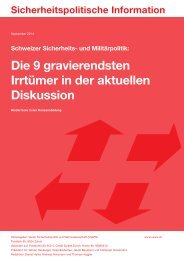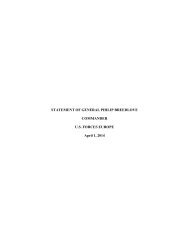FULLTEXT01
FULLTEXT01
FULLTEXT01
Create successful ePaper yourself
Turn your PDF publications into a flip-book with our unique Google optimized e-Paper software.
TACTICAL THOUGHT<br />
2014 September 29 th<br />
The third question; “What are typical traits argued for Irregular Warfare” addressed<br />
to the collection of texts can be answered with the following summary. First, one trait is<br />
that the activity is labelled and explained in slightly different ways. The political and<br />
civilian perspective, the violence spectrum from subversion to mobile warfare, the role<br />
of the police and the argued necessity of organization and administration can be seen as<br />
other typical traits.<br />
Discussion of the result<br />
The texts with their descriptions and explanations all have in common that they are<br />
written during the same time period of 1960-71, a period dominated by the<br />
revolutionary wars in Indo-china, Algeria, Malaya, Kenya and the growing fear of<br />
terrorism in the European mainland. The writers, except the historian professor<br />
Hahlweg, who can be seen as the link to Clausewitz and 19 th century views of<br />
“kleinkriege”, are all military professionals. Some of them, such as Trinquier and<br />
Thompson had extensive experience of working both as “irregulars” and “counterirregulars”<br />
in the field. Galula stands out as an example of an early warrior scholar and<br />
so might McCuen also be seen, despite not being as influenced as his French<br />
counterpart. Strictly historical academic perspectives stand side by side with<br />
practitioners’ emotional or more theoretical attempts, to not only explain but also solve<br />
the “Irregular riddle”. Of these, only Kitson is still alive, possibly to be asked if his<br />
articulations have been correctly understood. The result shows a fairly similar direction<br />
in expressions and explanations. Differences in details might be addressed at the<br />
different aims of the authors’ analyses and discussions rather than at their different<br />
views of what the phenomenon of Irregular Warfare is all about. These differences and<br />
many more not here expressed are in spite of or possibly due to, still drawing attention<br />
to several similar core aspects of Irregular Warfare.<br />
Period Three; “From 9/11 to 2010”<br />
James Corum<br />
James Corum defines Insurgency in his book Bad Strategies (2008) as; ”an attempt to<br />
overthrow an established government by violent means”. 404 The term Irregular Warfare<br />
is not used, but Insurgency is addressed as a form of warfare; “Insurgency is also a<br />
highly political form of warfare”. 405 Corum includes very different forms of<br />
insurgencies, from terrorist campaigns to Conventional Warfare. 406 All insurgents are<br />
said to have the same goal, to attain power. The range of influence activities is<br />
mentioned, from propaganda and organizing the people to military means. A<br />
characteristic is described as; “a war of choice for non-state groupings mounting<br />
challenges against governments”. 407<br />
404 James S. Corum, Bad Strategies (St. Paul: Zenith Press, 2008), p. 18.<br />
405 Ibid. p. 18.<br />
406 Ibid. p. 18.<br />
407 Ibid. p. 19.<br />
52





